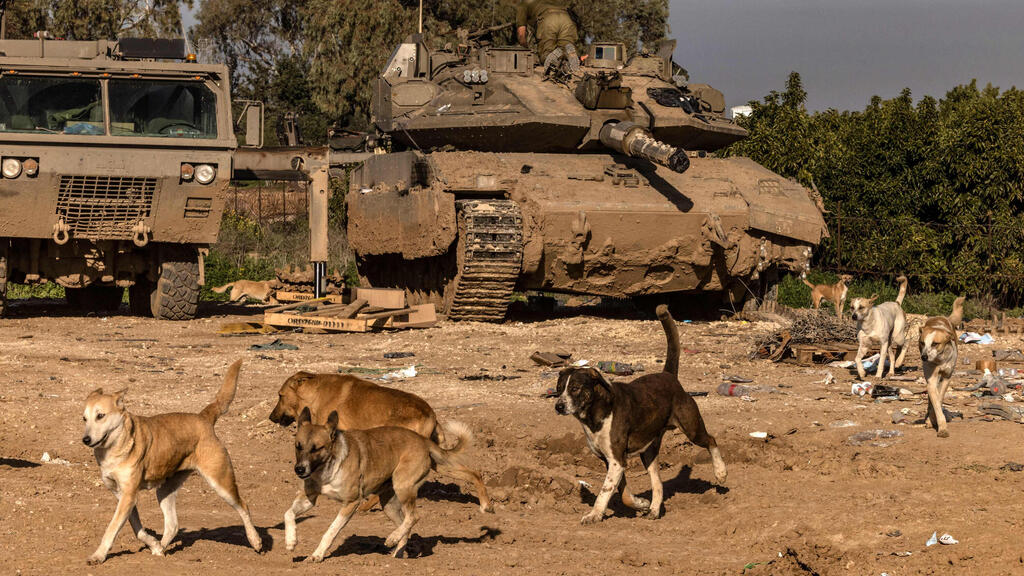Getting your Trinity Audio player ready...
Since the October 7 terror attack, Gaza border residents have faced a growing problem of stray dogs crossing into Israel.
The issue took center stage in a heated discussion Monday at the Knesset's Economic Affairs Committee, where Knesset lawmaker Yasmin Sacks-Fridman (Yesh Atid) presented an animal rights NGO investigation that found dogs are being held in severe neglect. She described the situation as “criminal and dangerous neglect.”
Gaza stray dogs in Israel
(Video: Kobi Sopper, Nature and Parks Authority)
Dr. Tamir Goshen, head of veterinary services at the Agriculture Ministry, said the allegations would be investigated. “When our staff visited the site, no evidence of abuse or neglect was found,” he said.
Dr. Hen Honig, the ministry’s animal welfare enforcement official, confirmed that a formal probe has been launched. “We received a large amount of raw footage from animal rights NGOs and we’re reviewing it thoroughly. It'll take time.”
Sacks-Fridman criticized the ministry’s failure to finalize long-awaited kennel regulations. “Why hasn’t this moved forward? It’s been nearly a decade. For years, the ministry has offered no long-term solutions — only cheap euthanasia. They pay 150 shekels ($40) to kill a dog and 400 shekels ($106) to a shelter that gives the dog care and finds it a home. That’s absurd.”
She also called on the ministry to support her proposed spay-neuter-return pilot program. “Stop opposing it. Some dogs are wild and may need to be euthanized but others can be sterilized and released. This method works in developing countries. With a three-year lifespan, we’ll see a humane shift within that time.”
Veterinary services official Sergio Dolev explained the ministry’s opposition: “This model suits urban strays that barely exist in Israel. It only works in closed populations where intervention is possible. Most problematic dogs in Israel are feral. For the program to succeed, we'd need 80% sterilization — and that’s impossible with dogs constantly entering from Gaza.”
Odelia Assouline-Dgani, the ministry’s head of regulation, added that spay-and-release violates Israeli law. “If I catch, treat and vaccinate a dog, I can’t just release it. I’m required to find it a home. This is a public safety and liability issue. There must be oversight.”
Get the Ynetnews app on your smartphone: Google Play: https://bit.ly/4eJ37pE | Apple App Store: https://bit.ly/3ZL7iNv
Goshen said the ministry is drafting updated kennel regulations, with a public version still pending. Dolev elaborated: “The new plan includes 16 key issues like budgets, kennel infrastructure, mapping local authorities and legislative changes.”
Prime Minister Benjamin Netanyahu’s animal rights advisor Tal Gilboa also spoke at the session, warning of collapsing shelter conditions. “Many shelters are under threat of closure, including the one in Sderot. Staff there are overwhelmed, underfunded and dealing with triple capacity — 200 dogs in 57 cages. The stray dog problem is huge. There aren’t enough adoptions — Israelis would rather buy dogs.”
She added that veterinarians are trapped in a moral and public pressure crisis. “When veterinarians avoid euthanasia, shelters pay the price. Medical teams are burned out. Vets are called murderers. They’re terrified of killing dogs because of the backlash they’ll face in this very committee,” she explained.
“Thousands of stray dogs have entered from Gaza and now the north is also seeing incursions,” Goshen concluded. “Building kennels is expensive and slow. Keeping dogs is costly and always will be. Adoption capacity is limited — only 20% of dogs in homes are adopted, the rest are purchased. Long-term kennel confinement is abuse. Is this what taxpayers should be funding?”






